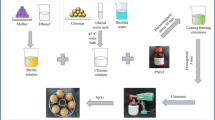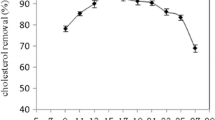Abstract
The objective of this study was to destabilize the protein–lipid complex in egg yolk precipitate obtained after the removal of soluble proteins, referred to as the pellet, through enzymatic treatment for further phospholipids extraction. A combination of proteolytic and lipolytic enzymes was applied to release the lipids from the pellet or weaken the pellet emulsion. Emulsions prepared using Protease P/Lipase AY30, Protease II/Lipase AY30 and Protease M/Lipase AY30 treated pellets had larger oil droplets (78, 65, 56 µm) and higher coalescence rates (51, 41, 35 %) than those of Protex 51FP, pellet, Protex 7L and Protease A with oil droplet size of 20, 18, 15 and 13 µm and coalescence rates of 31, 8, 7.5 and 8 %, respectively. Cream and liquid subnatant fractions obtained after further centrifugation of hydrolysates were subjected to lipid analyses. Over 90 % of phosphatidylcholine (PC) present in the pellet and 80 % of that in the original egg yolk were recovered in the cream from Protease P/Lipase AY30 treatment, while the recovery of PC from the egg yolk was significantly lower in creams from Protex 7L or Protease 51FP treatments (12 and 10 %, respectively). Pellets treated with Protease M, Protex 7L or Protex 51FP in combination with Lipase AY30 led to a significant loss of PC due to the conversion of PC to lysophosphatidylcholine or its degradation. Cream fractions obtained from the study represented a better material for the recovery of PL than intact egg yolk using environmentally-friendly techniques such as supercritical carbon dioxide (SC-CO2) extraction.





Similar content being viewed by others
References
Schmidt G, Bessman MJ, Hickey MD, Thannhauser SJ (1956) The concentration of some constituents of egg yolk in its soluble phase. J Biol Chem 223:1027–1031
McBee LE, Cotterill OJ (1979) Ion-exchange chromatography and electrophoresis of egg-yolk proteins. J Food Sci 44:656–660
Anton M, Gandemer G (1997) Composition, solubility and emulsifying properties of granules and plasma of egg yolk. J Food Sci 62:484–487
Kovacs-Nolan J, Mine Y (2004) Avian egg antibodies: basic and potential applications. Avian Poult Biol Rev 15:25–46
Kwan L, Lichan E, Helbig N, Nakai S (1991) Fractionation of water-soluble and water-insoluble components from egg yolk with minimum use of organic solvents. J Food Sci 56:1537–1541
De Meulenaer B, Huyghebaert A (2001) Isolation and purification of chicken egg yolk immunoglobulins: a review. Food Agric Immunol 13:275–288
Palacios LE, Wang T (2005) Egg-yolk lipid fractionation and lecithin characterization. J Am Oil Chem Soc 82:571–578
Zeisel SH (2006) Choline: critical role during fetal development and dietary requirements in adults. Annu Rev Nutr. 26:229–250
Gil A, Ramirez M, Gil M (2003) Role of long-chain polyunsaturated fatty acids in infant nutrition. Eur J Clin Nutr 57:S31–S34
Institute of Medicine, National Academy of Sciences USA (1998) Choline. Dietary reference intakes for folate, thiamin, riboflavin, niacin, vitamin B12, pantothenic acid, biotin, and choline. National Academy Press, Washington, DC, pp 390–422
Zhao YY, Xiong YP, Curtis JM (2011) Measurement of phospholipids by hydrophilic interaction liquid chromatography coupled to tandem mass spectrometry: the determination of choline containing compounds in foods. J Chromatogr A 1218:5470–5479
Palacios LE, Wang T (2005) Extraction of egg-yolk lecithin. J Am Oil Chem Soc 82:565–569
Gadkowski W, Chojnacka A, Kiebowicz G, Trziszka T, Wawrzenczyk C (2012) Isolation of pure phospholipid fraction from egg yolk. J Am Oil Chem Soc 89:179–182
Aro H, Jarvenpaa E, Konko K, Sihvonen M, Hietaniemi V, Huopalahti R (2009) Isolation and purification of egg yolk phospholipids using liquid extraction and pilot-scale supercritical fluid techniques. Eur Food Res Tech 228:857–863
Burley RW, Vadehra DV (1989) The avian egg: chemistry and biology. Wiley, New York
Towa LT, Kapchie VN, Hauck C, Murphy PA (2010) Enzyme-assisted aqueous extraction of oil from isolated oleosomes of soybean flour. J Am Oil Chem 87:347–354
Wu J, Johnson LA, Jung S (2009) Demulsification of oil-rich emulsion from enzyme-assisted aqueous extraction of extruded soybean flakes. Bioresour Technol 100:527–533
Sharma A, Khare SK, Gupta MN (2002) Enzyme-assisted aqueous extraction of peanut oil. J Am Oil Chem Soc 79:215–218
Daimer K, Kulozik U (2008) Impact of a treatment with phospholipase A(2) on the physicochemical properties of hen egg yolk. J Agric Food Chem 56:4172–4180
Buxmann W, Bindrich U, Heinz V, Knorr D, Franke K (2010) Influencing emulsifying properties of egg yolk by enzymatic modification by phospholipase D from Streptomyces chromofuscus part 1: technological properties of incubated egg yolk. Colloids Surf B 76:186–191
Wang G, Wang T (2009) Egg yolk protein modification by controlled enzymatic hydrolysis for improved functionalities. Int J Food Sci Tech 44:763–769
Hara A, Radin NS (1978) Lipid extraction of tissues with a low-toxicity solvent. Anal Biochem 90:420–426
Navidghasemizad S, Temelli F, Wu J (2014) Effect of enzymatic hydrolysis on the extractability of phospholipids from leftover egg yolk using supercritical CO2. Sep Purif Technol 122:192–198
Navidghasemizad S, Temelli F, Wu J (2014) Physicochemical properties of leftover egg yolk after livetins removal. LWT-Food Sci Technol 55:170–175
Sirvente H, Beaumal V, Gaillard C, Bialek L, Hamm D, Anton M (2007) Structuring and functionalization of dispersions containing egg yolk, plasma and granules induced by mechanical treatments. J Agric Food Chem 55:9537–9544
Kukis A (1985) Animal lecithins. In: Szuhaj BS, List CR (eds) Lecithins. AOCS Press, Champaign, p 105-162
Kovacs-Nolan J, Phillips M, Mine Y (2005) Advances in the value of eggs and egg components for human health. J Agric Food Chem 53:8421–8431
Haas MJ, Cichowicz DJ, Jun W, Scott K (1995) The enzymatic hydrolysis of triglyceride-phospholipid mixtures in an organic solvent. J Am Oil Chem Soc 72:519–525
Guilmineau F, Krause I, Kulozik U (2005) Efficient analysis of egg yolk proteins and their thermal sensitivity using sodium dodecyl sulfate polyacrylamide gel electrophoresis under reducing and nonreducing conditions. J Agric Food Chem 53:9329–9336
Mine Y (1998) Adsorption behavior of egg yolk low-density lipoproteins in oil-in-water emulsions. J Agric Food Chem 46:36–41
Bellairs R (1961) Structure of yolk of hens egg as studied by electron microscopy. 1. Yolk of unincubated egg. J Biophys Biochem Cytol 11:207–225
McClements DJ (2005) Food emulsions: Principles, practices, and techniques. CRC Press, Boca Raton
Damodaran S (2005) Protein stabilization of emulsions and foams. J Food Sci 70:R54–R66
van der Ven C, Gruppen H, de Bont DBA, Voragen AGJ (2001) Emulsion properties of casein and whey protein hydrolysates and the relation with other hydrolysate characteristics. J Agric Food Chem 49:5005–5012
Acknowledgments
This work was supported by grants from the Alberta Livestock Meat Agency, Ltd. (ALMA), Alberta Innovates - Bio Solutions (Al Bio), and Natural Sciences and Engineering Research Council of Canada (NSERC).
Author information
Authors and Affiliations
Corresponding authors
About this article
Cite this article
Navidghasemizad, S., Acero-Lopez, A., Curtis, J. et al. Destabilization of Egg Yolk Emulsion After IgY Removal Through Enzymatic Treatments. J Am Oil Chem Soc 91, 1857–1866 (2014). https://doi.org/10.1007/s11746-014-2542-y
Received:
Revised:
Accepted:
Published:
Issue Date:
DOI: https://doi.org/10.1007/s11746-014-2542-y




